| CHAPTER V: CATHEDRAL AND CHURCH LIBRARIES Old English libraries; the making, collection and use of books during the middle ages | ||
5. CHAPTER V: CATHEDRAL AND CHURCH LIBRARIES
1. § I
TO the books of the monastery some human interest clings: we can at once conjure up a picture of the cloister and the scribe at his work; the handling of an old manuscript, the turning over of finely-written and quaintly-illuminated yellow pages, throws the mind flashing back centuries to the silent writer in his carrell. But the church library is not rich in associations. It was a small "working" collection: one part for the use of the clergy, the other part—consisting of a few chained books—for the use of the people. These chained books, which now suggest a scarcely conceivable restriction upon the circulation of literature—even theological literature—were, in fact, the sign of a glimmer of liberal thought in the church. During the fourteenth and fifteenth centuries, not only were monastic books issued to lay people more freely, but many more books were chained in places of worship than in the sixteenth century, when the proclamation for the "setting-up" of Bibles in churches was granted unwillingly.
Some collections which later were distinctively church libraries were at first claustral. For convenience' sake we shall treat all of them as church libraries. The amount of information on medieval church libraries is surprisingly extensive, albeit a great deal more must remain hidden
Exeter Cathedral Library was a monastic hoard. It originated with
Bishop Leofric, who got together over sixty books about sixteen years
before the Conquest. His books were a curious collection: among copies
of the classics and ecclesiastical works were books of night songs,
summer and winter reading books, a precious book of blessings, and a
"Mycel Englisc boc"—a large English book, on all sorts of things,
wrought in verse. The last is the famous Exeter book, still preserved in
the library. A small folio of 130 leaves of vellum, it is remarkable to
the student of manuscripts for its bold, clear, and graceful
calligraphy, and priceless to the student of literature as the only
source of much of our small store of Anglo-Saxon poetry. Some other
Leofrican books remain. In the library of Corpus Christi College,
Cambridge, is an eleventh century copy of Bede's history in Anglo-Saxon,
which was given to Exeter by Leofric, although it is not mentioned in
the list of his gifts in the Bodleian manuscript. The inscription in it
reads: Hunc librum dat leofricus episcopus ecclesie sancti petri
apostoli in exonia ubi sedes episcopalis est ad utilitatem successorum
suorum. Si quis illum abstulerit inde, subiaceat malediction). Fiat.
Fiat. Fiat.[5.1] A manuscript of Bede on
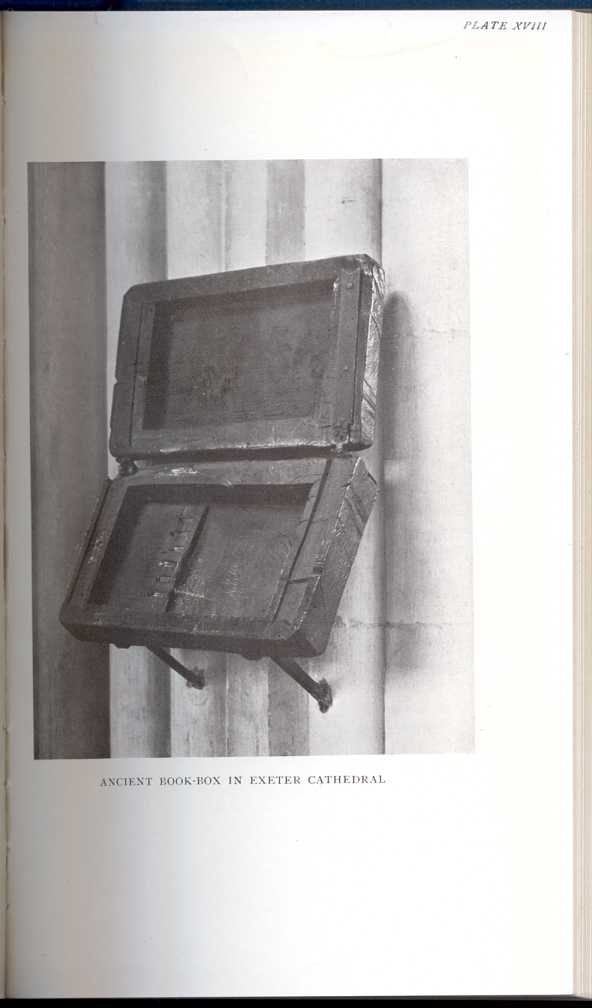 [Description: ANCIENT BOOK-BOX IN EXETER
CATHEDRAL]
[Description: ANCIENT BOOK-BOX IN EXETER
CATHEDRAL]
Although the age of these books suggests that the collection has existed continuously since the eleventh century, after Leofric's time no important reference to the library occurs until 1327, when an inventory of the books was drawn up. Then about 230 volumes (excluding service books) were in the possession of the Chapter. [5.4] In this same year a breviary and a missal were chained up in the choir for the use of the people. [5.5] Twelve months later John Grandisson arrived at Exeter to take charge of his diocese. A book-loving bishop, he was a benefactor to the library, maybe to a very praiseworthy extent; but a few words will record what is definitely known about this part of his work. In 1366 he gave two folio volumes, still extant. One contains Lessons from the Bible, and the homilies appointed to be read, and the other is the Legends of the Saints.[5.6] In his will he gave two other books, perhaps Pontificals of his own compilation, to his successors.[5.7] He himself owned an extensive library, which he divided principally between his chapter and the collegiate churches of Ottery, Crediton, and Boseham, and Exeter
A library room was built over the east cloister in 1412-13. [5.10] Probably the building was found necessary on account of a considerable accession of books, and we hazard a guess that Grandisson's bequest, received in 1370, formed the bulk of the accretion. At all events, among the accounts for the building are charges for 191 chains for books not secured before. No fewer than 67 books were also sewed or bound on this same occasion, the master binder being paid £6 and his man 36s. 8d. Thus at the beginning of the fifteenth century—the age of library building—the capitular hoard at Exeter was furbished up, newly housed, and arranged. But the interest in the collection seems to have waned. Another chain was bought for sixteenpence in 1430-31 for a copy of Rationale Divinorum, which was given by one Rolder; but such gifts were few and far between. In 1506 the Chapter owned
Besides the Exeter Book, one other very ancient and valuable manuscript is preserved in the Cathedral: this is the part of the Domesday Book referring to Devon, Cornwall, and Somerset, which is probably not much later in date than the Exchequer record. Two ancient book-boxes are also to be found there. These are fixed in a sloping position by means of iron supports embedded in the pillars. The late Dr. J. W. Clark was led to believe them to be intended for books by finding a wooden bookboard nailed to the inside bottom of one of the boxes. For the protection
2. § II
When gifts or bequests were received by a church or monastery, it was a beautiful custom to lay them, or something to represent them, upon the altar: "a book, or turf, or, in fact, almost any portable object, was offered for property such as land; or a bough or twig of a tree, if the gift were a forest." King Offa's gift of churches to Worcester monastery in 780 was accompanied by a great book with golden clasps, with every probability a Bible.[5.18] A gift was made under similar circumstances in c. 1057, about the time Bishop Leofric was founding the library at Exeter, when Lady Godiva, the wife of another Leofric, restored some manors to Worcester, and with them gave a Bible in two parts. Before this, Bishop Werfrith, to whom we have referred before as a helper of King Alfred, had sent to Worcester the Anglo-Saxon version of Gregory's Cura Pastoralis; the very copy of it is now in the Bodleian Library.
Such were perhaps the beginnings of the library of Worcester Cathedral. We cannot but think that a collection of books was formed slowly and steadily here, as in
At the Dissolution the Priory was deprived of much of its church plate, service books and vestments, and probably of many of its books. But the library there suffered a good deal less than those of other houses, and the Cathedral now has in its possession some respectable remains of its ancient collection of books. [5.21]
3. § III
The history of an old library can only be traced intermittently,
the facts playing hide and seek like a distant lantern carried over
broken ground. Little is known of the early history of Hereford's
cathedral library. An ancient copy of the Gospels, said to have been
bequeathed by the last Saxon bishop, Athelstan (1012), is one of the
earliest gifts. In 1186 Bishop Robert Folliott gave "multa bona in
ferris et libris." Bishop Hugh Folliott also left ornaments and books.
Another bishop, R. de Maidstone, although "vir magnae literaturae, et
in theologia nominatissimus," only seems to have given the church two
antiphonaries, some psalters, and a Legenda. Bishop Charleton
(1369) left a Bible, a concordance, a glossary, Nicholas de Lyra, and
five Books of Moses, all to be chained in the cathedral. Very shortly
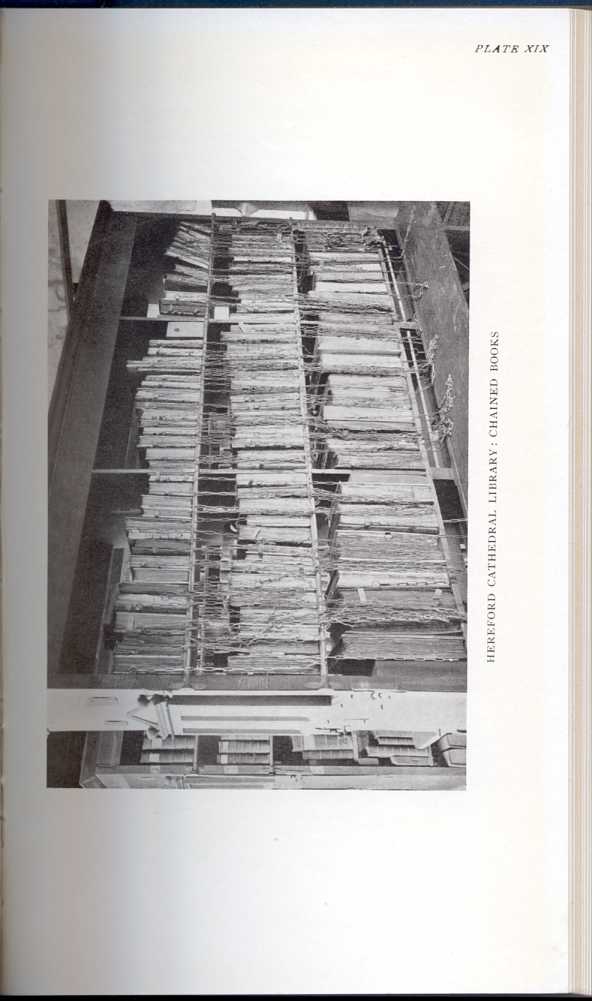 [Description: HEREFORD CATHEDRAL LIBRARY: CHAINED
BOOKS]
[Description: HEREFORD CATHEDRAL LIBRARY: CHAINED
BOOKS]
A new library was built in 1897. Herein are to be seen what are almost certainly the original bookcases, albeit they have been taken to pieces and somewhat altered before being fitted together again. One of the bookcases still has all the old chains and fittings for the books, and it presents a very curious appearance. Every chain is from three to four feet long, with a ring at each end, and a swivel in the middle. One ring is strung on to an iron rod, which is secured at one end of the bookcase by metal work, with lock and key. For convenience in using the book on the reading slope which was attached to the case, the ring at the other end of the chain was fixed to the fore edge of the book-cover instead of to the back; when standing on the shelves the books therefore present their fore edges to the reader. The cases are roughly finished, but very solid in make.[5.22]
4. § IV
At Old Sarum Church, Bishop Osmund (1078-99) collected, wrote, and bound books.[5.23] In his time, too, the chancellor used to superintend the schools and correct books: either books used in the school or service books. [5.24] The income from a virgate of land was assigned to correcting
5. § V
Books were given to Lincoln Cathedral about 1150 by Hugh of
Leicester; one of them bears the inscription, Ex dono Hugonis
Archidiaconi Leycestriae. They may still be seen at Lincoln.
Forty-two volumes and a map came into the charge of Hamo when he became
chancellor in 1150.[5.27] During his
chancellorship thirty-one volumes were added by gift, so making the
total seventy-three volumes: Bishops Alexander and Chesney were among
the benefactors. But here, as at
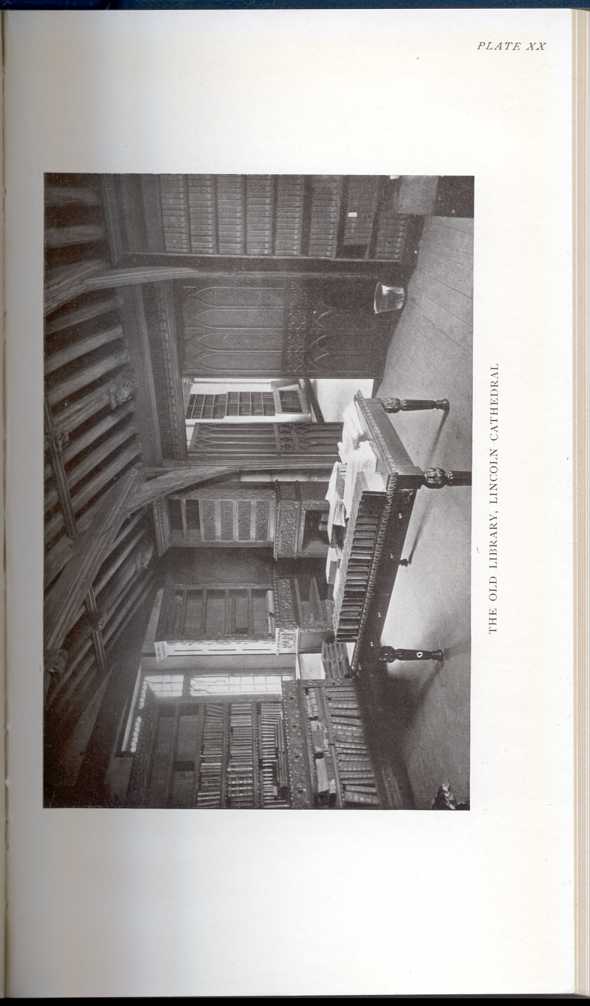 [Description: THE OLD LIBRARY, LINCOLN
CATHEDRAL]
[Description: THE OLD LIBRARY, LINCOLN
CATHEDRAL]
6. § VI
In an inventory of St. Paul's Cathedral, taken in 1245, mention is made of thirty-five volumes.[5.28] Before this, in Ralph of Diceto's time, a binder of books was an officer of the church. As at Salisbury, the chancellor's duties included taking charge of the school books. In 1283 a writer of books was included among the ministers. The two offices were combined in the beginning of the next century. When Dean Ralph Baldock made a visitation of St. Paul's treasury in 1295, he found thirteen Gospels adorned with precious metals and stones; some other parts of the Scriptures; and a commentary of Thomas
A library room was erected in the fifteenth century. "Ouer the East Quadrant of this Cloyster, was a fayre Librarie, builded at the costes and charges of Waltar Sherington, Chancellor of the Duchie of Lancaster, in the raigne of Henrie the 6 which hath beene well furnished with faire written books in Vellem."[5.31] The catalogue of 1458 bears out Stow's description of the library as well-furnished. Some one hundred and seventy volumes were in the Chapter's possession; they were of the usual kind, grammatical books, Bibles and commentaries, works of the fathers; books on medicine by Galen, Hippocrates, Avicenna, and Egidius; Ralph de Diceto's chronicles; and some works of Seneca, Cicero, Suetonius, and Virgil. [5.32] In 1486, however, only fifty-two volumes were found after the death of John Grimston the sacrist. [5.33] Leland gives a list of only twenty-one manuscripts, but it was not his habit to make full inventories. In Stow's time, however, few books remained. [5.34] Three volumes only can be traced now—(1) a manuscript of Avicenna, (2) the Chronicle of Ralph de Diceto in the Lambeth Palace Library, and (3) the Miracles of the Virgin, in the Aberdeen University Library.[5.35]
7. § VII
Although neither a monastic nor a collegiate church, Wells was already in the thirteenth century a place with some equipment for educational work. Besides the choristers' school, a schola grammaticalis of a higher grade was in existence. After 1240 the Chancellor's duties included lecturing on theology. Not improbably, therefore, a collection of books was formed very early. And indeed the Dean and Chapter in 1291 received from the Dean of Sarum books lent by the Chapter, and some others bequeathed to them. Hugo of St. Victor, Speculum de Sacramentis, and Bede, De Temporibus, were the books returned from Sarum; among those bequeathed were Augustine's Epistles and De Civitate Dei, Gregory the Great's Speculum, and John Damascenus. We know nothing of the character and size of the library at this time, although it seems to have been preserved in a special room. In 1297, the Chapter ordered the two side doors of the choir screen in the aisles to be shut at night. One door near the library (versus librarium) and the Chapter was only to be open from the first stroke of matins until the proper choir door was opened at the third bell. At other times during the day it was always to be closed, so that people could not injure the books in the library, or overhear the conferences of the Chapter (secreta capituli). This library was most likely on the north side of the church, with the Chapter House beside it, in the north transept, as shown conjecturally in the plan given in Canon Church's admirable Chapters in the Early History of the Church of Wells.[5.36] That so early, in a church neither monastic nor collegiate, a school was at work, and a
In this position the library remained until the fifteenth
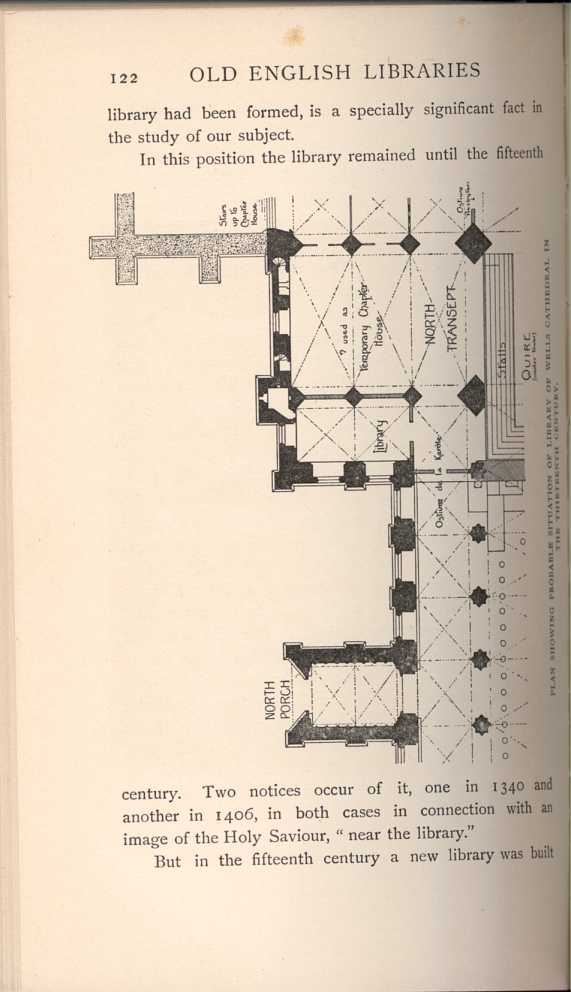 [Description: PLAN SHOWING PROBABLE SITUATION OF
LIBRARY OF WELLS CATHEDRAL IN THE THIRTEENTH CENTURY.]
[Description: PLAN SHOWING PROBABLE SITUATION OF
LIBRARY OF WELLS CATHEDRAL IN THE THIRTEENTH CENTURY.]
But in the fifteenth century a new library was built
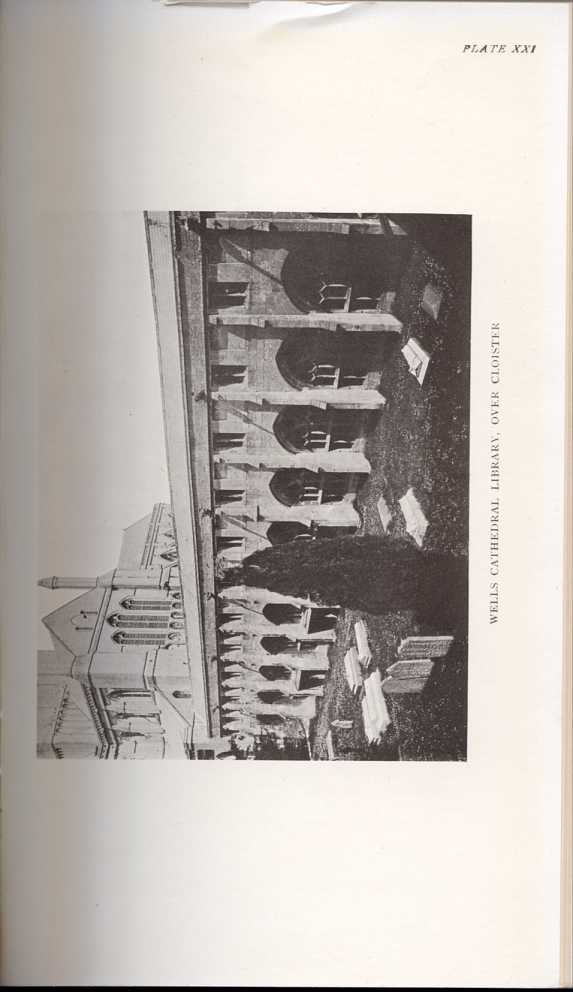 [Description: WELLS CATHEDRAL LIBRARY, OVER
CLOISTER.]
[Description: WELLS CATHEDRAL LIBRARY, OVER
CLOISTER.]
Shortly after the date of Bubwith's will Bishop Stafford (1425-43) gave ten books—not an inspiriting collection— but he desired to retain possession of them during his lifetime. [5.38] In 1452 Richard Browne (alias Cordone), Archdeacon of Rochester, left to the library of Wells, Petrus de Crescentiis De Agricultura, and two other books, Jerome's Epistles, and Lathbury Super librum Trenorum, which were to be kept in the church in wooden cases. [5.39] Were these cases to resemble the boxes still remaining in Exeter Cathedral? The same will ordered the Decretales of Clement, which had been borrowed for copying, to be restored to this library; two other books were also given back;
Leland only mentions forty-six books in the library in his time. "I went into the library, which whilome had been magnificently furnished with a considerable number of books by its bishops and canons, and I found great treasures of high antiquity." Among the books he found were sermons by Gregory and Ælfric in Anglo-Saxon, Terence, and "Dantes translatus in carmen Latinum." Very few books belonging to the old library before the Dissolution have survived. Some are in the British Museum, the Bodleian, and certain collegiate libraries; and several manuscripts remain in the hands of the Dean and Chapter. Among them are three manuscripts known as Liber albus I, Liber ruber II, and Liber albus III, which contain an extremely valuable series of documents.[5.41]
8. § VIII
In the York fabric rolls appear from time to time expenses for writing, illuminating, and binding church books; but we know little or nothing about the Chapter library, if such existed. William de Feriby, a canon, bequeathed his books in 1379. Between 1418 and 1422, a library was built at the south-west corner of the south transept. The building is in two floors, and the upper appears to have been the book-room; it is still in existence. In the rolls are several references to the building.
1419. Et de 26l. 13s. 4d. de elemosina domini Thomae Haxey ad cooperturam novi librarii cum plumbo.
Haxey was a good friend to the cathedral; and he gave handsomely toward the library. His arms were put up in one of the new library windows.
1419. In sarracione iiij arborum datarum novo librario per Abbatem de Selby, 6/8.
1419. Et Johanni Grene, joynor, pro joynacione tabularum pro libraria et planacione et gropyng de waynscott, per annum, 17s. 8d.
In operacione cc ferri in boltes pro nova libraria per Johannem Harpham, fabrum, 8s.[5.42]
In 1418 John de Newton, the church treasurer, bequeathed to the Chapter a number of books, including Bibles, commentaries, and patristical and historical works, as well as Petrarch's De remediis utriusque fortunae.[5.43] They were chained to the library desks, and were guarded with horn and studs, to protect them from the consequences of careless use by readers.
1421. Johanni Upton pro superscriptura librorum nuper magistri Johannis Neuton thesaurarii istius ecclesiae legatorum librario, 2s. Thomae Hornar de Petergate pro hornyng et naillyng superscriptorum librorum, 2s. 6d. Radulpho Lorymar de Conyngstrete pro factura et emendacione xl cathenarum pro eisdem libris annexis in librario predicto, 23s. Id. [5.44]
From time to time a few other bequests were made: thus, Archdeacon Stephen Scrope bequeathed some books on canon law, after a beneficiary had had them in use during his life (1418). Robert Ragenhill, advocate of the court of York, enriched the church with a small collection (1430); and Robert Wolveden, treasurer of the church, left to the library his theological books (1432). [5.45]
9. § IX
The Sacrist's Roll of Lichfield Cathedral, under date 1345, contains en inventory of the books then in possession of the church. All of them were service books, excepting only a De Gestis Anglorum. [5.46] Thereafter we cannot discover a notice of the library until 1489, when Dean Thomas Heywood gave £40 towards building a home for the books. Dean Yotton assisted in the good work. By 1493 the building was finished. It stood on the north side of the Cathedral, west of the north door, or "ex parte boreali in cimeterio."[5.47] The Dean and Chapter had it pulled down in 1758.
Nearly all the books of the early collection perished during the Civil War; but the finest manuscript, known as St. Chad's Gospels, was saved by the preceptor. Among the other manuscripts in the possession of the Chapter are a fine vellum copy of Chaucer's Canterbury Tales, with beautiful initials, and the Taxatio Ecclesiastica, a tithe book showing the value of church property in Edward I's time.[5.48]
10. § X
Many other churches, some of them small and unimportant, owned books, and received them as gifts or bequests. In the time of Richard II the Royal collegiate chapel of Windsor Castle had, besides service books, thirty-four volumes on different subjects chained in the church, among them a Bible and a Concordance, and two books of French romance, one of which was the Liber de Rose.[5.49]
The library of St. Mary's Church, Warwick, was first formed by the celebrated antiquary, John Rous. Before his time we hear only of one or two books. In 1407 there was a collection of fifty service books, and a Catholicon, the latter being perhaps the nucleus of a library.[5.50] "At my lorde's auter," that is, at the Earl of Warwick's altar, were to be found among other goods and books, the Bible, the fourth book of the Sentenccs, Pupilla Oculi, a work by Reymond de Pennaforte, Isidore, and some canon law.[5.51] John Rous seems to have inherited the bookish tastes of his relative, William Kous. William had bequeathed his books to the Dean, charging him to allow John to read them when he came of age and had received priest's orders.
Among the Harleian MSS. in the British Museum is a small volume
written on parchment by Humphrey Wanley, which includes a copy of a
curious inventory of vestments, plate, books, and other goods made in
the time of John Rous, 1464. A portion of this inventory has been
printed in Notices of the Churches of Warwickshire, i. 15—16.
"It. v bokes beynge in the handes of Maister John Rous now priest
whuche were Sir William Rous and bequath hem to the Dean and Chapitre of
the forseide Chirche Collegiall under condicōn that the seid
maister John beynge priest shulde have hem for his special edificacon
duryng his fief. And after his decees to remayne and to be for ever to
the seide Dean and Chapitre as it appereth by endentures thereof made
whereof one party leveth with the Dean and Chapitre. That is to say i
book quem composuit ffrater Antoninus Rampologus de Janis 2 fo Chorinth
14. It. 1 book cald pars dextera et pars sinistra 2 fo non
 carere. It. 1 bible versefied
cald patris in Aurora 2 fo huic opifox. It. 1 book of powles epistoles
glosed 2 fo de Jhu qui dr
carere. It. 1 bible versefied
cald patris in Aurora 2 fo huic opifox. It. 1 book of powles epistoles
glosed 2 fo de Jhu qui dr
John also seems to have given books as well as a room to house them.[5.52] An old view of the church, taken before the great fire which destroyed the town in 1694, shows the south porch surmounted with his library, as then standing; but this room was destroyed in the fire, and it seems certain the books were burnt. The present library was founded in 1701, and includes no part of the original collection.[5.53]
Bequests to churches of service books, such as that to the church of St. Mary, Castle-gate, York (1394), were numerous; they may be set apart with bequests of vestments, plate, and money. Some bequests have a different character. A chancellor of York, Thomas de Farnylaw, leaves books, bound and unbound, to the Vicar of Waghen; a volume of sermons and a "quire" to the church of Embleton; and a Bible and Concordance to be chained in the north porch of St. Nicholas' Church, Newcastle, "for common use, for the good of the soul of his lord William of Middleton" (1378). A chaplain leaves service books, Speculum Ecclesiae, and the Gospels in English to Holy Trinity Church, Goodramgate, York (1394). A Bristol merchant bequeaths two books on canon law to St. Mary Redcliffe Church, there to be preserved for the use of the vicar and chaplains (1416). In the same year a Canon of York enriches Beverley Church with all his books of canon
A very little research would add considerably to our list; while, apart from records of gifts and bequests, are numberless references to books in churches. For example: in the churchwarden's account book (c. 1525) of All Saints, Derby, occurs an entry beginning: "These be the bokes in our lady Chapell tyed with chenes yt were gyffen to Alhaloes church in Derby—
- Item A boke called Summa Raumundi [Summa poenitentia et matrimonio of Reymond de Pennaforte of Barcelona].
- Item Anoyer called pupilla occult [Pupilla oculi, by J. de Burgo].
- Item Anoyer called the Sexte [Liber Sextus Decretalium].
- Item A boke called Hugucyon [see pp. 223-4].
- Item A boke called Vitas Patrum.
- Item Anoyer boke called pauls pistols.
- Item A boke called Januensis super evangeliis dominicalibus [Sermons of Jacobus de Voragine, Abp. of Genoa, on the Gospels for the Sundays throughout the year].
- Item a grette portuose [a large breviary].
- Item Anoyer boke called Legenda Aurea [Legenda sanctorum aurea of Jacobus de Voragine].[5.55]
In primis one Boke called summa summarum.
This is a respectable list for such a church. Some sixty years before there were apparently only service books (1465). [5.56]
From 1456 to 1475 charges occur in the accounts of St. Michael's Church, Cornhill, for chains to fix psalters, and for writing. [5.57] At St. Peter's upon Cornhill there would appear to have been a good library. "True it is," writes Stow, "that a library there was pertaining to this Parrish Church, of olde time builded of stone, and of late repayred with bricke by the executors of Sir John Crosby Alderman, as his Armes on the south end doth witnes. This library hath beene of late time, to wit, within these fifty yeares, well furnished of bookes: John Leyland viewed and commended them, but now those bookes be gone, and the place is occupied by a schoolemaister."[5.58] In 1483 the Church of St. Christopher-le-Stocks, London, seems to have had a collection only of service books; but five years later mention is made of "a grete librarie." "On the south side of the vestrarie standeth a grete librarie with ii longe lecturnalles thereon to lay on the bookes." [5.59] About the middle of the sixteenth century certain inhabitants of Rayleigh held a meeting one Sunday, after service, and, without the consent of the churchwardens, sold fifteen service books, and "four other manuscript volumes," as well as some other church goods, for forty shillings. [5.60]
But we might continue for a long time to bring together
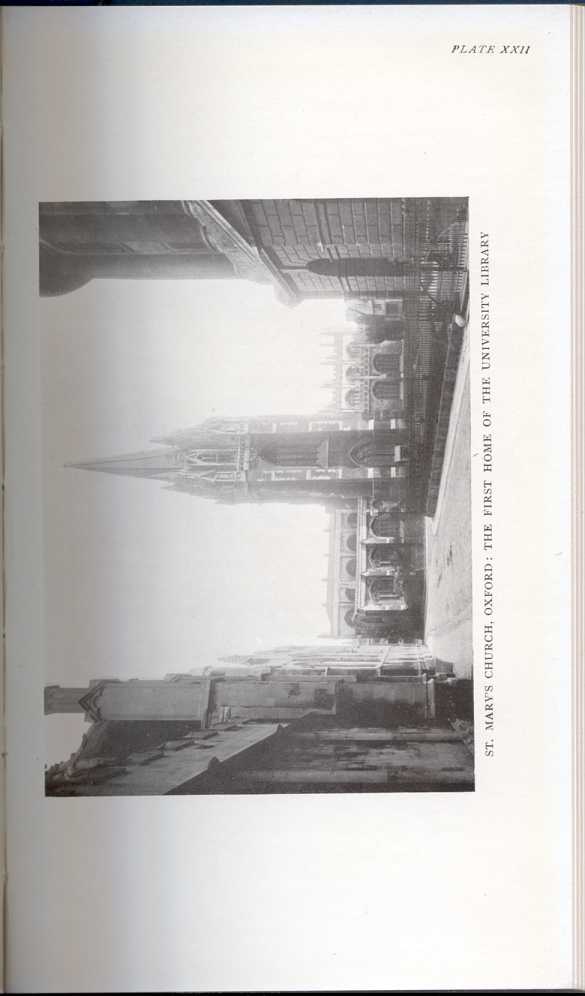 [Description: ST. MARY'S CHURCH, OXFORD: THE
FIRST HOME OF THE UNIVERSITY LIBRARY]
[Description: ST. MARY'S CHURCH, OXFORD: THE
FIRST HOME OF THE UNIVERSITY LIBRARY]
MS. Bodl., Auct. D. 2. 16 fo. I a; Dugdale, ii. 527; Oxford Philol. Soc. Trans., 1881-83, p. 2,
Ego I. de G. Exon., do Eccle. Exon librum istum cum pari suo, in festo Annuntiationis Dominice. Manu mea, anno consecrationis mee xxxix.—Oliver, Lives of the Bps., 85.
In 1329 he wrote to Richard de Ratforde from Chudleigh: "Regraciamur vobis quod Librum Sermonum Beati Augustini pro nobis, prout Magister Ricardus filius Radulphi, ex parte nostra, vos rogavit, retinuistis, nobisque et condiciones ejusdem significastis et precium. Et, quia ipsum Librum habere volumus, lx solidos sterlingorum Magistro Johanni de Sovenaisshe [Sevenashe], Magistro Scolarum nostre Civitatis Exoniensis, pro ipso Libro tradi fecimus, ut nobis eundem, quamcicius nuncii securitas affuerit, transmittatis. Libros, eciam, Theologicos Originales, veteres saltem et raros, ac Sermones antiquos, eciam sine Divisionibus Thematum, pro nostris usibus exploretis; scribentes nobis condiciones et precium eorundem." O.H.S., 27 Boase, 2.
I have to thank my friend Mr. Tapley Soper, F.R,Hist,S., for his willing help in sending me information about this library.
Our account of church libraries will appear inadequate if it is not borne in mind that we do not propose to go beyond the manuscript age. An excellent account of modern church libraries is given in English Church Furniture, in this series. Also see Clark, 257.
The best account of Worcester Cathedral Library is in Reliquary, vii. Il, by the Rev. J. K. Floyer, M.A.
In the fifteenth century the bishops of Wells were good friends of learning: Skirlaw gave books to University College, Oxford; Bowet left a large library; Stafford gave books; Bekynton was the companion of the most cultivated men of his time. Dean Gunthorpe is well known as a pilgrim to Italy, who returned laden with manuscripts (see p. 192).
L. A. R., viii. 372; Canon Church's account of the library, in Archaeologia, lvii. pt. 2, is very full and interesting.
Johannes Rous, capellanus Cantariae de Guy-Cliffe, qui super porticum australem librariam construxit, et libris ornavit. Gentleman's Magazine (N.S), xxv. 37. The chapel of Guy's Cliffe was erected by Richard Beauchamp for the repose of the soul of his "ancestor," Guy of Warwick, the hero of romance.
Mr. W. T. Carter, of the Warwick Public Library, has kindly given me much information about St. Mary's Church library.
Arch. Inst. City of York (1846), 10-11; Surtees Soc., iv. 102-103, 196; xiv. 57-59, 159, 171, 220-222, 221n; xxvi. 2-3; xxx. 219, 275; Cox and Harvey, English Church Furniture, 331; Mun. Acad., 648-649; Library, i. 411; Cam. Soc., Bury Wills, 253.
Cox, J. C., and Hope, W. H. St. John, Chronicles of the Colleg. Ch. o All Saints, Derby (1881), 175-177.
| CHAPTER V: CATHEDRAL AND CHURCH LIBRARIES Old English libraries; the making, collection and use of books during the middle ages | ||